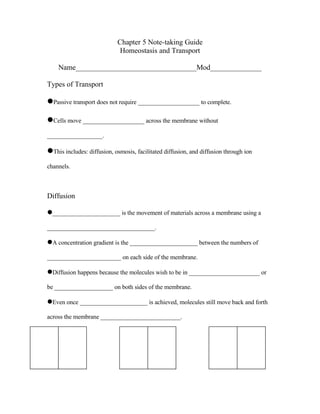
Chapter 5 Note
- 1. Chapter 5 Note-taking Guide Homeostasis and Transport Name_________________________________Mod______________ Types of Transport Passive transport does not require ____________________ to complete. Cells move ____________________ across the membrane without __________________. This includes: diffusion, osmosis, facilitated diffusion, and diffusion through ion channels. Diffusion ______________________ is the movement of materials across a membrane using a ___________________________________. A concentration gradient is the ______________________ between the numbers of ________________________ on each side of the membrane. Diffusion happens because the molecules wish to be in _______________________ or be ___________________ on both sides of the membrane. Even once ______________________ is achieved, molecules still move back and forth across the membrane __________________________.
- 2. Osmosis ______________________ is the diffusion of _____________________ across the cell membrane. Only __________________ is moved in __________________. The direction of osmosis depends on the ___________________________ of molecules outside and inside of the cell. Hypotonic If the concentration of molecules outside the cell is _____________________ than the concentration inside the cell’s cytoplasm, then the solution is called ___________________. Water will move ___________________ the cell to create _______________________. Hypertonic When the solution ____________________________ the cell has more molecules than inside the cell, the solution is _______________________. Water will move ____________________ of the cell to create equilibrium. Isotonic Both the solution and the inside of the cell are ___________________. Water will move both ways ________________________ to maintain ___________________________.
- 3. How Cells Deal with Osmosis Some animals are only single celled organisms like the _________________________. The paramecium is a _________________________ pond dweller. These paramecia are functioning in a __________________________ environment all the time so water is constantly _____________________ into the organism. Paramecia have ___________________________________ that remove excess water from their bodies. Sometimes when too much water is added, cells burst and this is called __________________________.
- 4. How Plants Deal with Osmosis Since plants have a ____________________, osmosis affects them differently. When osmosis moves ________________ into plant cells, the cell membrane swells but stops against the strong cell wall. This is called _____________________________. When plants don’t receive enough water, ___________________________ occurs which makes the plants _________________. The cell membrane ______________________ away from the cell wall. Facilitated Diffusion This process is used for molecules that can’t move _______________________ through the cell membrane. ______________________________ help move the molecules.
- 5. The molecules still move down the ________________________________ so no energy is required. Transport of _______________________ is facilitated diffusion. Diffusion through Ion Channels Ions such as sodium, potassium and calcium need a ________________________________ because they cannot pass through the membrane on their own. Each type of channel is ______________________ to an ion. Some channels are always open and some have gates that ____________________________________ depending on the need for the ion.
- 6. Active Transport This type of transport goes up or against the ____________________________________. Since that is working uphill, _________________________ is required. This includes: sodium-potassium pump, endocytosis, and exocytosis Sodium-Potassium Pump This involves a ____________________________________. To function normally, animal cells must have a _______________________________________ of sodium outside their cells and a high concentration of potassium inside their cells. The ________________________________________ works to maintain these differences.
- 7. As __________________________ comes into the carrier protein and moves outside the cell, _________________________ comes into the protein and moves inside. They switch places. Endocytosis Some substances such as food particles are too ______________________ to move through the cell membrane. In endocytosis, the cell encloses external materials in a __________________________ made from the cell membrane and moves them into the cell. The pouch is called a ______________________. There are two types of endocytosis:__________________________ involves transport of fluid and ______________________________ involves transport of solids or whole cells. Many animals use phagocytosis to ingest ______________________ or _________________________ that invade the body.
- 8. Exocytosis Exocytosis is the reverse. In exocytosis, molecules or cells are ______________________________ to the outside of the cell from the inside. Vesicles are used. Cells used _____________________________ to release large molecules like ______________________________ into the body from the cell. Usually the _________________ and the _________________________ are involved in this process.
